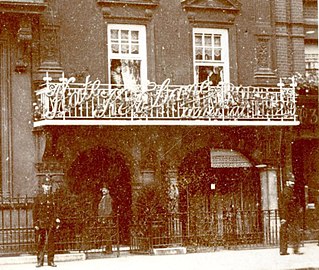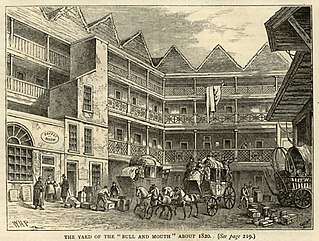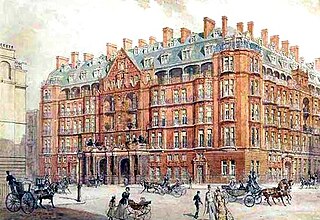
John Gellibrand Hubbard, 1st Baron Addington PC, was a City of London financier and a Conservative Party politician.
Harriet Anne Scott, Lady Scott (1816–1894), was a British novelist, born in India, and of Scottish descent.

Alan Peter Dumayne was an historian of North London known for his lectures and books on the history of Southgate, Palmers Green, and Winchmore Hill.

Herbert Francis Wauthier was an English engraver known for his bookplate designs. He was also mayor of the borough of Southgate (1936–37), and a freeman of the City of London.
Savannah Johnson Speak was an English mining engineer and metallurgist. He received a technical education at the Yorkshire College and the Royal School of Mines after which he worked in mining around the world and lectured in metallurgy at the University of Sydney. He was in business as a consultant engineer in London and was president of the Institution of Mining and Metallurgy from 1922-23.

Catherine Ker-Lane was a successful society dressmaker and businesswoman of the late nineteenth and early twentieth centuries who traded as Madame Kate Ker-Lane's Court Dress Emporium in Kensington, London, but was noted for the poor conditions in which her staff worked.

Samuel Sugden was an English merchant from Leeds who built Oak Lodge in north London, after which the district of Oakwood is named.

Thomas Fulljames FRIBA was an architect active in Gloucestershire, England, in the first half of the nineteenth century. As diocesan surveyor from 1832 until 1870, latterly in partnership with Frederick Sandham Waller, he designed, reconstructed or extended a number of churches in Gloucestershire.

Gustavus Charles Philip Murray was a British obstetrician who may have been the inspiration for Luke Fildes' 1891 painting The Doctor. His work in the examination of pregnant women was recognised by Adolphe Pinard in 1889 but ignored in England. He was popular with his patients and had a thriving practice with many professional appointments but as a result wrote little. He died at the age of 56 years from heart failure.

William Henry Prior was a British painter and engraver known for his depictions of London and its environs. He provided sketches for the Environs of London (1842), and worked for Charles Knight and Henry Vizetelly on the Illustrated Times.

Edward Sherman was a stagecoach proprietor from Berkshire who became the second largest operator of stagecoaches in England after William Chaplin.
Joseph Salter was a Christian missionary in London who worked with migrants to the United Kingdom in the nineteenth century. He was particularly known for his work with lascars and later for his work with ayahs. He taught himself several Indian languages and wrote two books describing his work.

Tito Eduardo Achille Mattei was an Italian pianist, composer, and conductor.

Beaver Hall was a country house in Middlesex, England. It was set in grounds of around 40 acres (16 ha) that stood to the east and south of the current Waterfall Road, then known as Waterfall Lane and Church Hill, near the old centre of Southgate. The grounds stretched as far south as the Pymmes Brook where Arnos Park was later built. Beaver Hall was acquired by John Walker of the Taylor-Walker brewing family in 1870. The house was demolished in 1871 and the grounds merged into the adjacent Arnos Grove estate.

Charles William Stephens was a British architect. As architect to the Harrods department store in London from 1892 until his death, he was responsible for the store's famous Baroque-style façade on Brompton Road. His other designs include Harvey Nichols department store, the new Claridge's hotel, 54 Parkside, and the Park Lane Hotel, all in London.
Albert Estcourt was a builder in Gloucestershire, England, in the 19th century who with his brother, and later on his own, constructed a number of notable buildings in the county and across southern England.

Evangeline Florence was an American-born soprano who built a successful concert career in Great Britain.
Ada Dorée was an English singer and actor who performed in operetta, Victorian burlesque, and pantomime from the 1870s to the 1890s. In her early life she was Ada Catherine Elizabeth Earée, and in her later years she used the name Ada Dorée-Thorne, adding that of her husband.

Reginald Crompton was a British solicitor, stage actor and silent film screenwriter. A bass-baritone, he created several minor roles in the Savoy Operas with the D'Oyly Carte Opera Company.
Basil Joseph Mathews was an English historian, biographer, and writer on the ecumenical movement.














